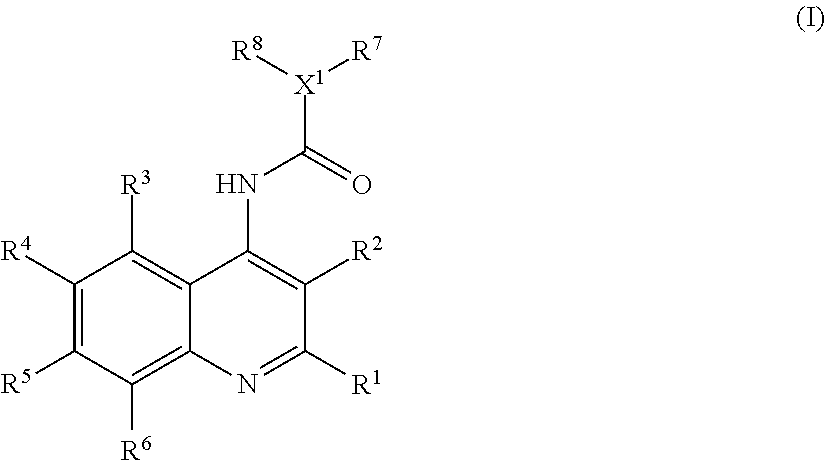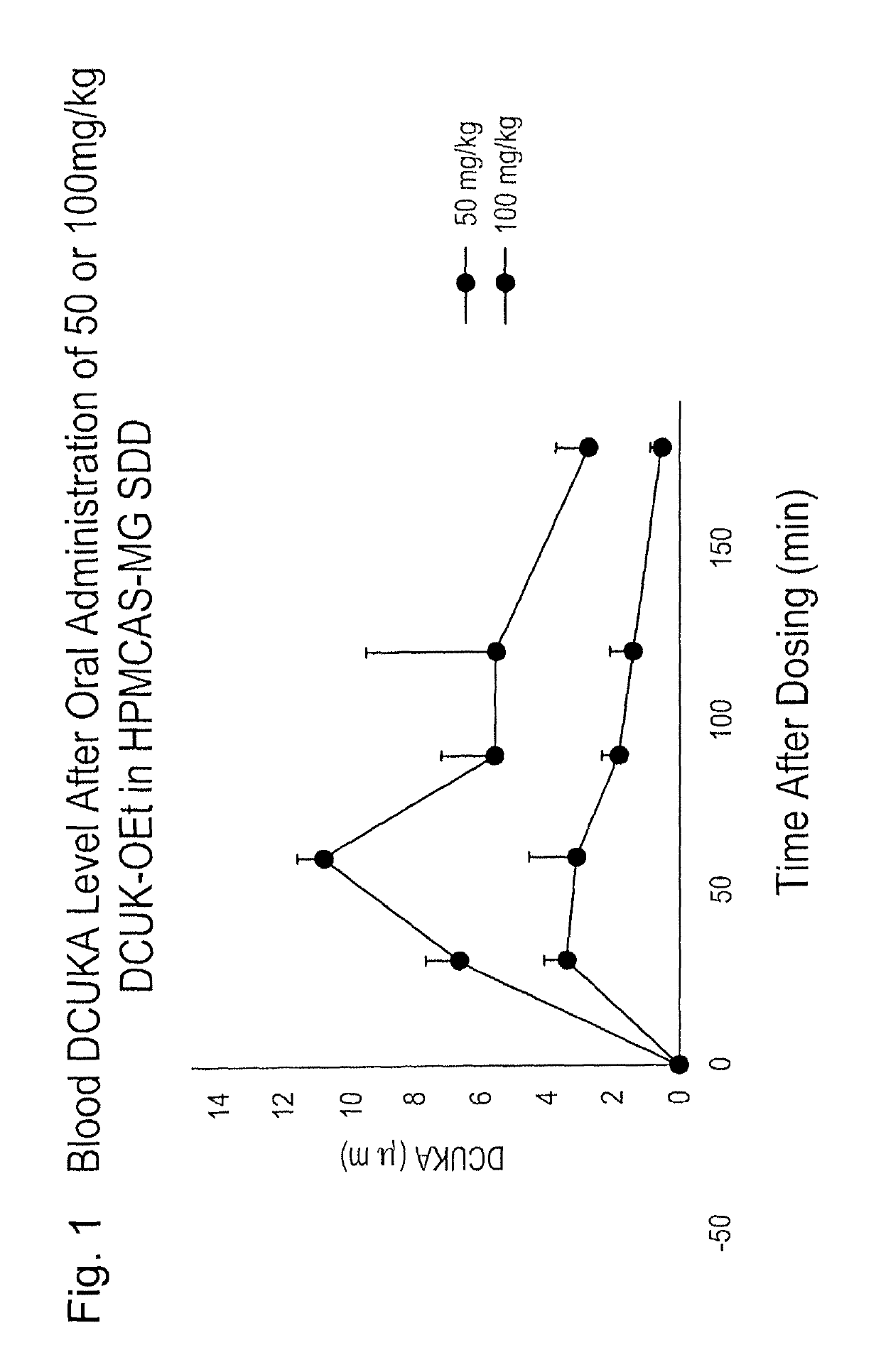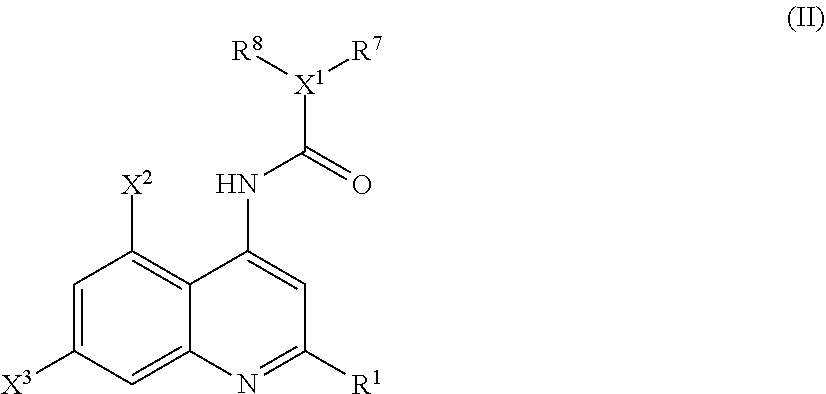Analgesic compositions
a technology of compositions and analgesics, applied in the field of analgesic compositions, can solve the problems of negative affecting the quality of life, opiate addiction, dose escalation, etc., and achieve the effect of promoting treatment and effectively ameliorating mechanical or thermal allodynia/hyperalgesia
- Summary
- Abstract
- Description
- Claims
- Application Information
AI Technical Summary
Benefits of technology
Problems solved by technology
Method used
Image
Examples
example 1
on of Compounds of Formula (VI)
[0100]Derivatives of kynurenic acid containing a tertiary ureido group, including 5,7-dichloro-4-(3,3-diphenylureido)quinoline-2-carboxylic acid (DCUKA, 7a), may be synthesized, as previously described (Snell et al., 2000) through the use of a reactive carbamoyl chloride intermediate (6a-b). However, it is possible to achieve an improvement on this synthesis due to concomitant ester hydrolysis during the final acylation reaction. One compound embodiment, 5,7-dichloro-4-(3,3-dibutylureido)quinoline-2-carboxylic acid (BCUKA, 7b), was synthesized via this method in the synthesis phases I-IV as explained and illustrated in Scheme 2 (Reagents and conditions (I): MeOH, reflux, 16 h. (II): Ph2O, 250° C., 2 h. (III): (a) C1SO2NCO, MeCN, reflux, 2 h. (b) HCl, MeOH, RT, 30 min. (IV): NaH, DMF, 0° C. to RT, 16 h).
[0101]
[0102]3,5-Dichloroaniline (1, 5.00 g, 30.9 mmol) and dimethyl acetylenedicarboxylate (2, 3.80 ml, 30.9 mmol) were combined in anh...
example 2
UK-OEt as a Pro-Drug for DCUKA In Vivo
[0126]This example illustrates that DCUKA is rapidly formed in vivo by ester hydrolysis after oral administration of DCUK-OEt to rats. This study was performed in accordance with the NIH Guide for the Care and Use of Laboratory Animals. A spray-dried dispersion of DCUK-OEt with the polymer HPMCAS-MG (HPMCAS-MG SDD) was prepared by Catalent Pharma. This SDD contained 15 mg of DCUK-OEt and 85 mg of the polymer per 100 mg SDD. A preparation of 0.5% hydroxypropyl methylcellulose (HPMC) was prepared by heating 100 ml of water to 60-75° C. A separate aliquot of 100 ml of water was cooled to 5° C. 500 mg of HPMC was added to 50 ml of the hot water while stirring, and then 50 ml of the cold water was added. Stirring was continued until a clear solution was formed. To make a suspension of the SDD, 15 ml of 0.5% HPMC, in aliquots, was added to a vial containing 1 g of SDD. The mixture was triturated until a uniform slurry was formed, containing 10 mg / ml o...
example 3
of Neuropathic Pain by DCUKA, BCUKA and DCUK-OEt
[0130]This example illustrates the ability of DCUKA, BCUKA and DCUK-OEt to reverse neuropathic pain, measured as mechanical or thermal pain, induced by cisplatin (cancer chemotherapy), Complete Freund's Adjuvant (CFA) (inflammatory pain), or diabetes (streptozotocin-induced pain) or monoiodoacetate (MIA) (osteoarthritic pain).
[0131]All studies were performed in accordance with the NIH Guide for the Care and Use of Laboratory Animals.
[0132]Drugs.
[0133]For in vivo studies of cisplatin, CFA and STZ-induced pain, DCUKA or BCUKA or DCUK-OEt, or gabapentin, were prepared in a 50% gelatin / 50% canola oil emulsion (this emulsion was used as vehicle). The gelatin was prepared by adding 0.8 g of gelatin Knox, Kraft Foods North America, Tarrytown N.Y.) and 0.06 g tartaric acid (McCormick and Co., Inc., Hunt Valley, Md.) to 30 ml of purified water. The solution was heated at 98° C. for 20 minutes, then cooled to 50° C. Six ml of 95% alcohol and wat...
PUM
| Property | Measurement | Unit |
|---|---|---|
| pH | aaaaa | aaaaa |
| body mass | aaaaa | aaaaa |
| temperature | aaaaa | aaaaa |
Abstract
Description
Claims
Application Information
 Login to View More
Login to View More - R&D
- Intellectual Property
- Life Sciences
- Materials
- Tech Scout
- Unparalleled Data Quality
- Higher Quality Content
- 60% Fewer Hallucinations
Browse by: Latest US Patents, China's latest patents, Technical Efficacy Thesaurus, Application Domain, Technology Topic, Popular Technical Reports.
© 2025 PatSnap. All rights reserved.Legal|Privacy policy|Modern Slavery Act Transparency Statement|Sitemap|About US| Contact US: help@patsnap.com



